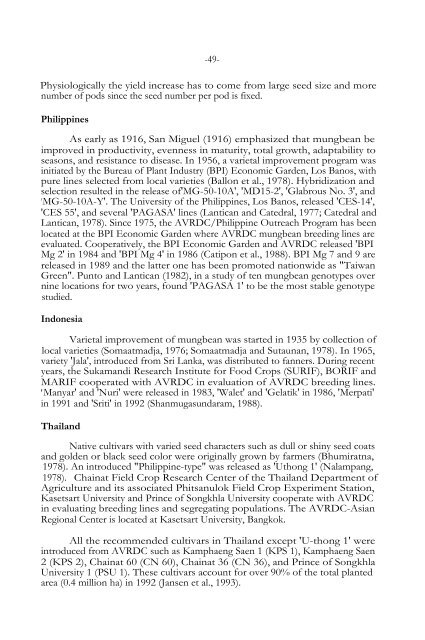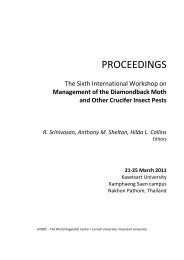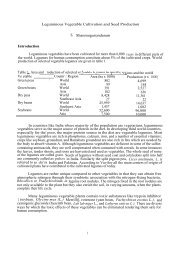MUNGBEAN VARIETAL IMPROVEMENT S. Shanmugasundaram
MUNGBEAN VARIETAL IMPROVEMENT S. Shanmugasundaram
MUNGBEAN VARIETAL IMPROVEMENT S. Shanmugasundaram
You also want an ePaper? Increase the reach of your titles
YUMPU automatically turns print PDFs into web optimized ePapers that Google loves.
-49-<br />
Physiologically the yield increase has to come from large seed size and more<br />
number of pods since the seed number per pod is fixed.<br />
Philippines<br />
As early as 1916, San Miguel (1916) emphasized that mungbean be<br />
improved in productivity, evenness in maturity, total growth, adaptability to<br />
seasons, and resistance to disease. In 1956, a varietal improvement program was<br />
initiated by the Bureau of Plant Industry (BPI) Economic Garden, Los Banos, with<br />
pure lines selected from local varieties (Ballon et al., 1978). Hybridization and<br />
selection resulted in the release of'MG-50-10A', 'MD15-2', 'Glabrous No. 3', and<br />
'MG-50-10A-Y'. The University of the Philippines, Los Banos, released 'CES-14',<br />
'CES 55', and several 'PAGASA' lines (Lantican and Catedral, 1977; Catedral and<br />
Lantican, 1978). Since 1975, the AVRDC/Philippine Outreach Program has been<br />
located at the BPI Economic Garden where AVRDC mungbean breeding lines are<br />
evaluated. Cooperatively, the BPI Economic Garden and AVRDC released 'BPI<br />
Mg 2' in 1984 and 'BPI Mg 4' in 1986 (Catipon et al., 1988). BPI Mg 7 and 9 are<br />
released in 1989 and the latter one has been promoted nationwide as "Taiwan<br />
Green". Punto and Lantican (1982), in a study of ten mungbean genotypes over<br />
nine locations for two years, found 'PAGASA 1' to be the most stable genotype<br />
studied.<br />
Indonesia<br />
Varietal improvement of mungbean was started in 1935 by collection of<br />
local varieties (Somaatmadja, 1976; Somaatmadja and Sutaunan, 1978). In 1965,<br />
variety 'Jala', introduced from Sri Lanka, was distributed to fanners. During recent<br />
years, the Sukamandi Research Institute for Food Crops (SURIF), BORIF and<br />
MARIF cooperated with AVRDC in evaluation of AVRDC breeding lines.<br />
'Manyar' and 'Nuri' were released in 1983, 'Walet' and 'Gelatik' in 1986, 'Merpati'<br />
in 1991 and 'Sriti' in 1992 (<strong>Shanmugasundaram</strong>, 1988).<br />
Thailand<br />
Native cultivars with varied seed characters such as dull or shiny seed coats<br />
and golden or black seed color were originally grown by farmers (Bhumiratna,<br />
1978). An introduced "Philippine-type" was released as 'Uthong 1' (Nalampang,<br />
1978). Chainat Field Crop Research Center of the Thailand Department of<br />
Agriculture and its associated Phitsanulok Field Crop Experiment Station,<br />
Kasetsart University and Prince of Songkhla University cooperate with AVRDC<br />
in evaluating breeding lines and segregating populations. The AVRDC-Asian<br />
Regional Center is located at Kasetsart University, Bangkok.<br />
All the recommended cultivars in Thailand except 'U-thong 1' were<br />
introduced from AVRDC such as Kamphaeng Saen 1 (KPS 1), Kamphaeng Saen<br />
2 (KPS 2), Chainat 60 (CN 60), Chainat 36 (CN 36), and Prince of Songkhla<br />
University 1 (PSU 1). These cultivars account for over 90% of the total planted<br />
area (0.4 million ha) in 1992 (Jansen et al., 1993).

















